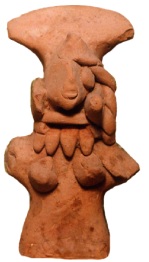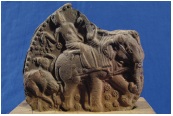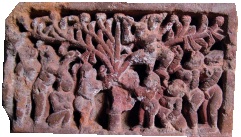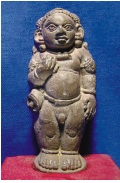
Terracotta or burnt clay was the common man's medium for making works of art in India as elsewhere. Although the earliest examples of clay figurines, both of animals and human beings, go back in time to 7000 B.C. at places like Mehargarh in Baluchistan, yet the beautiful images were made during the Early Bronze Age (4000 B.C.-2800 B.C.). The most notable examples belong to the Mother Goddess group from the Harappan sites (2700-2000 B.C.) i.e. like Mohenjodaro, Mehargarh, Nausaro, Dholavira, Kalibangan, Banawali, Barror and Harappa. The continuity of the tradition was maintained even during the 2nd Millennium B.C. in the village sites like Nevasa, Inamagon etc.

The art of terracotta gets matured in the hands of city dwellers in the Ganga basin sites like Rajghat, Kaushambi, Buxar, Pataliputra, Ahicchhatra etc. In the beginning they were completely hand modeled but from Mauryan period (321 B.C.) onward the faces were cast from molds at sites like Mathura & Rajghat. Soon after the Mauryan period, during Sunga period plaques were produced from the single molds. The technique greatly improved in the early centuries of the Christian era under the rules of Satavahanas in the Deccan and Kushanas in the north at sites like Ter and Kondapura, Chandraketugarh and Kaushambi respectively; double moulds were used to make the images in round. Now through these methods images were produced in mass and distributed over large areas. T

The themes chosen were sometimes everydays toys but very often they included Mother Goddess, �r� Lakshmi Yaksha and Yaksh�, Udayan-Vasavdutta, R�m�yan scene, Mithuna and Dampati and different Hindu gods and goddesses. While some were for decoration, others were for worship.

During the Gupta period (319-578 A.D.) the terracottas matched with the stone sculptures both in quality and quantity. Brick temples at Ahicchhatra, Sarnath, Bhitargaon and other places in Uttar Pradesh were decorated with large plaques depicting scenes from the Mah�bh�rata, R�m�yana and the Puranas. The major sites represented here by most exquisite examples are Rajghat, Mathura, Kaushambi, Sr�vasti, Bhitari, Akhnoor (Jammu).

During the Post Gupta period the history of the art of terracotta was bright only in isolation, mostly in Eastern India when the Palas and Senas ruled here from 9th to 12th centuries A.D. Temples, stupas and monasteries at sites like, Mainamati, Paharpur, Antichaka etc. were decorated with plaques depicting mythological stories. In more recent times, during the 18th- 19th centuries, once again terracotta plaques decorated the brick temples of Bengal. However, they included many themes of contemporary life like ships with European sailors. Although quantitatively they reached a high peak yet qualitatively they were far inferior than those of the classical period.